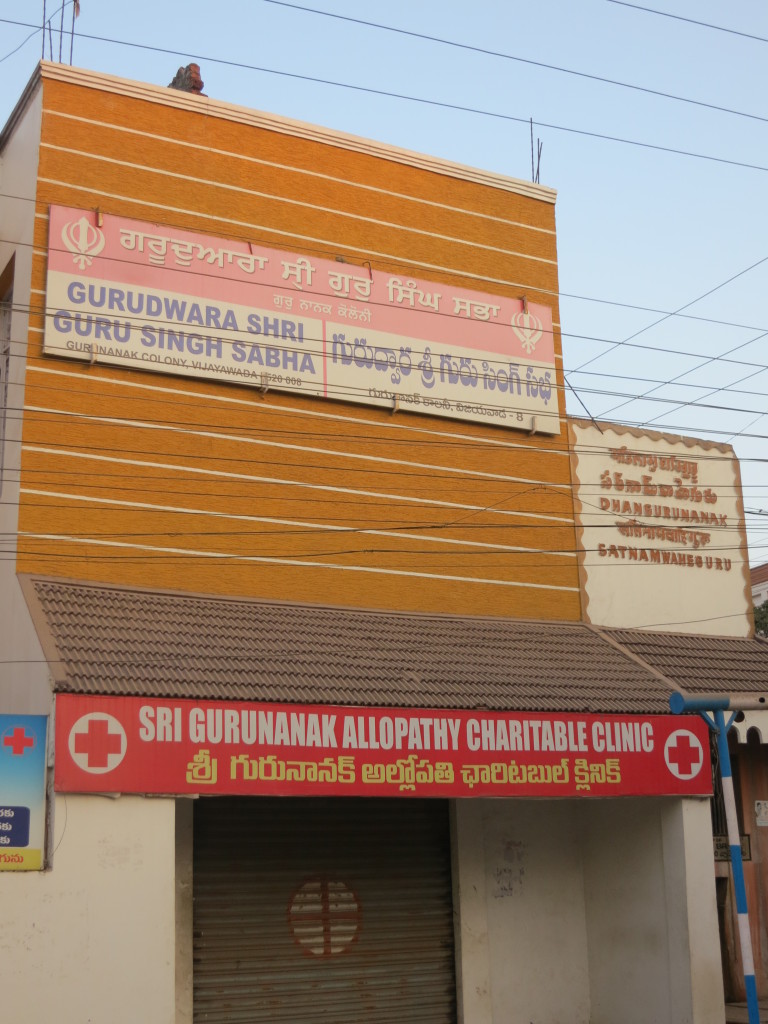If you visit the Gurudwara at Guru Nanak Nagar in Vijayawada on a weekend you’ll be greeted by a host of young Dakhani Sikh boys in orange head gears running around and playing cricket in the courtyard. These boys hail from poor families of Dakhani Sikhs in the villages of Warangal district in Andhra Pradesh and have been adopted by the Sikh community of Vijayawada that seeks to provide them the amenities that every child should grow up with, i.e. food on their plates, a healthy living environment and a school education that would take them ahead in life by opening up job opportunities for them. The Gurudwara in Guru Nanak Nagar has residential quarters on the first floor to accommodate these children and the members of the community contribute funds every month to pay for the food, education and other caregiving expenses for the children.
The Sikh community in Vijayawada comprises pre- and post-partition migrants from Pakistan. Some of them came directly to settle in Vijayawada before and immediately after the partition while others migrated to places like Uttar Pradesh and Delhi first and then made it to Vijayawada at the behest of their kin to tap into the business potential offered by the city. Presently they form a small minority of over 50 families in the city.
The Sindhis in Vijayawada too migrated as a result of the partition and were given shops by Mahatma Gandhi in the One Town area of Vijayawada. Almost everybody who was interviewed had a “rags to riches” story to share which is typical of first generation migrants who have to work hard to establish their businesses in a new place.
The Sikhs, Sindhis, Gujarati and Marwari communities are collectively lumped together as “North Indians” by the local Telugu community in Vijayawada. While most of the Sikhs today own auto spare-parts businesses, the Sindhis, Gujaratis and Marwaris engage in varied trades like garments, footwear, jewelery, paints, wires, hardware, plywood and stainless steel.
The first generation of Sikhs and Sindhis who migrated from Pakistan and other parts of North India had to start from scratch and some had to start their businesses on sidewalks, small rented shops and even sell dry-fruits at the railway station. Today most of them own big houses (350-500 square yards each) and shops in Guru Nanak Nagar and Auto Nagar which are prime locations in the city. They say that they owe this abundance to the first generation migrants (their fathers and grandfathers) most of whom are now dead for their thoughtfulness in making the right investments at the right time.
Mr Chandnani, a senior member and leader of the Sindhi community in Vijayawada felt that the Sindhis had it even worse than the Sikhs who at least got half of the state of Punjab after the country was divided while they had lost the whole of Sindh to Pakistan and had nowhere to call home in the newly created state of India. A young Sindhi leader and entrepreneur Mr Dinesh Achphelia, the owner of a chain of garment stores in Andhra called the MNM stores said, that unlike the Gujaratis and Marwaris settled in Vijayawada they do not have a home state to make investments in and hence invest their savings in the state of Andhra Pradesh. The Sindhis have been among the most proactive people in responding to disasters and other kinds of crises and have enriched the social and cultural life of Vijayawada like their other diasporic “North Indian” counterparts.
The men in the Sikh, Sindhi and Gujarati communities alike said that the local Telugu community were very supportive of the migrants when they first arrived providing them with equal opportunities and a healthy competition to pursue their businesses. They said that integration with the locals was not an issue as they all peacefully coexisted in the city and celebrated festivals and weddings together. They felt that the Telugu society was accepting of the “North Indians” more than the other South Indian states and they were comfortably able to run and expand their businesses in this state.
The women in these diasporic “North Indian” communities however were more critical about issues of integration and pointed to the fact that the differences in the culture and mindsets of the Telugu and the non-Telugu societies were marked and could not be done away with. This, they observed could be gauged from the way these communities were socially and spatially organized within the city and also by noticing their daily interactions with each other.
In a focus group discussion the women said that the differences between the Telugu and non-Telugu groups in Vijayawada can be most prominently experienced in Telugu-dominated schools by their children where leadership roles are often not assigned to the non-Telugu children. They also observed that the Telugu, non-Telugu relations had also been changing over time. The earlier generations of the locals were much more accepting and tolerant of the migrants when they first arrived than the present generation as things had been changing of late due to the impacts of globalization, rapid urbanization and market competition in the city. The city has sprawled over the years from being centered around the One Town area, the commercial hub during the colonial period, towards the present day Auto Nagar which was once upon a time at the outskirts of Vijayawada.
The first Sikh family to arrive in Vijayawada was the Kandhari family. It was the sons of Atma Singh Kandhari, Sangat Singh and Harbans Singh and their three brothers from Rawalpindi in Pakistan who arrived as early as 1946 in Vijayawada. Late Sardar Sangat Singh Kandhari the son of Atma Singh Kandhari was the earliest arrival in the city. He worked as an accountant in the army prior to the partition and was well travelled in different parts of India. He was a travelling salesman and frequented Hyderabad and Chennai (Madras in those days) for work.
In 1946 when talks about the partition were at their peak, he decided to move to India with his family and chose the banks of the Krishna River in Vijayawada to settle down since it was a peaceful place and an important trading centre. Being a major junction in the South Central Railway zone of the Indian railways it was also well connected to the rest of the country and an important node for trades of different goods. Even in the 1950s, the older members of the community said that there were daily trains to Delhi from Vijayawada. Sangat Singh’s son Darshan Singh Kandhari was two years old when he accompanied his father to Vijayawada. Today as a 71-year-old he says that the city has been home for him, his children and grandchildren since then. The fifth generation of his family is now living there.
Sangat Singh Kandhari’s family initially had a tough time adjusting to the new place since food consumption patterns and the climatic regime was entirely different from what they had been used to in the north. Vijayawada, at that time a part of the state of Madras, was in a rice-eating belt and wheat was not available when they first arrived. Also, winter as experienced in Northern India, did not exist in Vijayawada. The summers were particularly uncomfortable with the temperature soaring up to 50 degrees Celsius.
At one point of time he contemplated moving to Mumbai but his wife refused to move to the big city since she did not want to get packed into a small apartment life typical of Mumbai and liked the openness of the living environment in Vijayawada. She would use rice powder to make rotis, the staple diet of the Punjabis for meals. It was later in the 1960s when wheat grain started coming to the market in Vijayawada that the Punjabi community could resume their wheat-eating habits. Some of them even travelled up to Hyderabad to buy wheat in those days.
When he first arrived Sangat Singh Kandhari set up a truck servicing center. His son Darshan Singh said that after the 2nd World War for ten years trading of all kinds took place in One Town area of Vijayawada. Slowly the auto-parts and some other businesses shifted to Governorpet and from the year 1958 to 1975, Governorpet was the only market for auto-parts businesses. In 1975 the government of Andhra Pradesh announced the setting up of Auto Nagar in Vijayawada that would be governed by the AP Industrial Infrastructure Corporation (APIIC). It is then that many Sikhs purchased shops in Auto Nagar and moved their businesses there. Some of them stayed behind in Governorpet at a street called Besant Road and continued to operate from there.
Sangat Singh Kandhari’s maternal uncle Gulab Singh Oberoi followed the Kandharis to Vijayawada soon after. Popularly referred to as “Mamaji” he along with Sangat Singh is credited for many contributions to the city-making process. The first achievement with which both of them are credited is the setting up of the Gurudwara behind the Gandhi Hill in One Town in 1957. Sangat Singh Kandhari along with the other members of his community raised the money for building the Gurudwara from the Sikhs in different states. In 1968, the Punjabi and the Sindhi community actively led the work for the creation of a crematorium called Swargpuri opposite the main bus terminal in Vijayawada. The crematorium was subsequently handed over to the Vijayawada Municipal Corporation for operation and maintenance. More recently in 2012 a gas-based, low pollution crematorium was inaugurated next to the older wood based one. Once again different communities contributed money for the establishment of this crematorium which is the second gas-based crematorium in India with the Sindhis contributing the maximum—Rs 33 lakhs—followed by the Telugu and other groups.
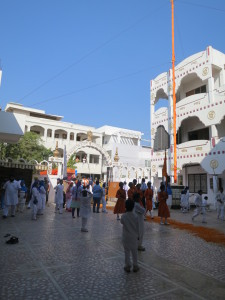
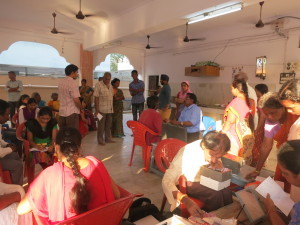
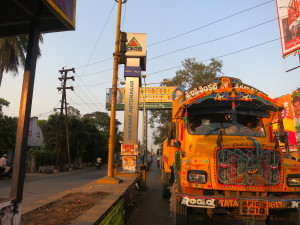
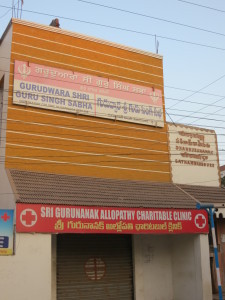

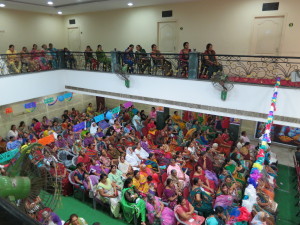
Paramjeet Singh, another first generation migrant Sikh who arrived in Vijayawada in 1977 from Delhi where his family had moved from Pakistan after the partition, said that a super-cyclone struck the place in the year he moved to the city and he felt that the Sikhs were very actively involved in the reconstruction process as they built 100 houses for disaster-affected people in Divi Taluka of Krishna district. Paramjeet Singh, an auto parts dealer, himself has been immersed in community building work since he arrived and conducts Punjabi language classes at the Gurudwara for the younger generation of Sikhs in Vijayawada free of cost. He ensures that they pick up the language skills that are necessary to maintain and practice their identity as Sikhs and are able to read their holy script – the Gurbani.
Another contribution of the Sikh community to Vijayawada and its surrounding villages is the eye-camp that they conduct in the Gurudwara every first Sunday of the month where poor people can get their eyes tested for free and also get medicines and free eye operations done at a hospital, the charges for which are borne by the members of this community. The community also runs allopathic and homeopathic medicine dispensaries for the public.
The earliest Sindhi family to arrive in Vijayawada immediately after the partition of the subcontinent was that of Manhar Achphelia. Manhar Achphelia was 12 years old when he accompanied his father to the city. When he grew up he started a saree business in the city. He would purchase the sarees from Mumbai and sell them in the villages surrounding Vijayawada. His sons Dinesh Achphelia and his brother now run a chain of stores called MNM in Andhra Pradesh that sell readymade garments for men, women and children.
Manhar Achphelia led the effort for the establishment of the Sindhu Bhawan and temple in Vijayawada which would bind the Sindhi community together by providing a space for community activities. Presently there are over 280 Sindhi families in Vijayawada. Dinesh Achphelia explains that the Sindhis are among the most cosmopolitan communities as their religious and cultural beliefs emanate from both Hinduism and Islam. Their main deity is Jhulelal who they consider to be an incarnation of the Hindu God of water. Some Sindhis also follow Sufism. They also believe in Sikhism and Guru Nanak is one of their main deities.
Mr Achphelia said that their community adjusted to the local foods and incorporated more rice and pickles in their diet. They rented accommodations in the older parts of the city but as their businesses grew the “North Indian” groups wanted to own houses of their own. That is when the Guru Nanak colony was established at the outskirts of the city by acquiring agricultural land which was then divided into residential plots for different North Indian groups. Sangat Singh Kandhari initiated a cooperative society called the Guru Nanak Cooperative Society in 1975 in which 80 members from different communities signed up to purchase land at the outskirts of the city. The society purchased eleven and a half acres of this land and had it converted into non-agricultural land use. Plots of different sizes, i.e. 350, 500 and 600 square yards, were then divided and distributed to the members of the cooperative society. 2000 square yards of land was kept aside for building the Gurudwara which was eventually built in 1992. Some land was also allocated for building a Hindu temple in the colony which was constructed in 1998.
Mr Achphelia said that during a regional clash between two political groups in December 1988 following the murder of a Congress MLA there was a caste riot in Vijayawada and different communities got caught in the crossfire. Their shop, for instance, was burnt down by the rioting mobs and they suffered a huge financial setback. They however sprung back with their hard work and dedication and today are among the wealthiest families in Vijayawada.
The first generation of Sindhi and Punjabi migrants may have struggled to establish a foothold in the city of Vijayawada, but they ensured that their children had it much better than them. Most of the first generation migrants have given the best education to their children both in India and abroad. Despite belonging to a relatively “conservative” community Dinesh Achphelia sent his daughters to do their MBA at the University of Glasgow in the UK. He said that he wanted his daughters to manage his stores and participate actively in running the family business. When asked how he sees the future of Vijayawada now that the new capital Andhra Pradesh – Amravati will be located so close by, he expressed the apprehension that crime and traffic in the city will increase in the next few years.
The Sindhi community maintains good relations with the Gujarati, Marwari and Punjabi communities. In February 2015 the Gujarati community hosted a Geeta recital at the Sindhu Bhawan in Vijayawada in which all the other North Indian communities participated actively. The Sindhu Bhawan also rents out its community hall to other groups when they ask for it.
The arrival of the first Gujarati family—the Patels—in Vijayawada pre-dates the partition. Harish Patel who owns a stainless steel business in the city said that his father arrived in the city in 1926 and started selling coconuts from coastal Andhra to Gujarat. Harish Patel did not want to continue that work since he had attained a degree in Mechanical Engineering and wanted to venture into manufacturing. He set up a manufacturing unit for stainless steel utensils in 1975. His unit is presently located in Auto Nagar but he says many of the other members of the Patel community run plywood and hardware businesses in the old part of the city in Governorpet. He has three sons of whom two have ventured into the garments business and one continues to help him.
According to Mr Patel there are around 250 Gujarati families in the city. The Gujarati Samaj was established in 1945 and the community celebrates the festival of Navratri with great fervor. They also run a Gujarati school in the One Town area which admits poor children from all the other communities too.
The North Indian diasporic groups in Vijayawada have established themselves fairly well in the city through their hard work and the business potential that the city as a historical trading city offered. The struggles of the first generation migrants has led to securing comfortable lifestyles for their subsequent generations most of whom now own houses, cars and businesses in the city and frequently travel abroad for holidays and studies. These diasporic groups bond more closely among themselves rather than across communities as can be observed by examining their community lives. Being smaller in size than the majority Telugus, they also feel that they are more closely scrutinized by the members of their own communities.
With the formation of the new capital—Amravati—in the close proximity to Vijayawada, definitely the number of migrants in and around the city will increase. With increasing job opportunities and improved physical and social infrastructure we can only hope that Vijayawada is heading towards a more cosmopolitan future. With the influx of multinational corporations as envisaged by the government and as experienced in the case of Hyderabad, there will be an inflow of skilled professionals which will cause the gentrification of some more neighborhoods in Vijayawada. With these changes we can expect an increased role for the pre-existing diasporas and the new migrants in the city-making process who will now be a part of global city making along with the international players involved in the process.

